broadcast & production microphones
AT8015
Line + Gradient Condenser Microphone
Features
• Designed for video production and broadcast (ENG/EFP) audio
acquisition
• Provides the narrow acceptance angle desirable for long-distance
sound pickup
• Smooth, natural-sounding on-axis audio quality
• Offers the convenience of battery or phantom power operation
• Rugged design and construction for reliable performance
• Switchable 80 Hz high-pass lter minimizes pickup of undesired
low-frequency sounds
Description
The AT8015 is a xed-charge condenser microphone with a line +
gradient polar pattern. It is designed for video production, broadcast
(ENG/EFP) audio acquisition, wildlife recording and high-quality sound
reinforcement.
The microphone requires 11V to 52V phantom power or a 1.5V AA
battery for operation. A battery need not be in place for phantom power
operation.
The microphone's highly directional polar pattern provides a narrow
acceptance angle along with crisp, intelligible audio reproduction
desirable for long-distance sound pickup.
The output of the microphone is a 3-pin XLRM-type connector.
A switch permits choice of at response or low-frequency roll-off (via
integral 80 Hz high-pass lter) to help control undesired ambient noise.
The microphone is enclosed in a rugged housing. The included AT8405a
stand clamp permits mounting on any microphone stand with
5
/
8
"-27
threads. A windscreen, two o-rings, a battery and a protective carrying
case are also included.
Operation and Maintenance
The AT8015 requires 11V to 52V phantom power or a 1.5V AA battery for
operation. A battery need not be in place for phantom power operation.
To install the battery, unscrew the lower section of the microphone body,
just below the nameplate. Insert a fresh 1.5V AA battery in the handle
compartment (“+” end up), then reassemble the microphone. Alkaline
batteries are recommended for longest life. Remove the battery during
long-term storage.
Output is low impedance (Lo-Z) balanced. The signal appears across Pins
2 and 3; Pin 1 is ground (shield). Output phase is “Pin 2 hot”— positive
acoustic pressure produces positive voltage at Pin 2.
To avoid phase cancellation and poor sound, all mic cables must be wired
consistently: Pin 1-to-Pin 1, etc.
An integral 80 Hz high-pass lter provides easy switching from a at
frequency response to a low-end roll-off. The roll-off position reduces
the pickup of low-frequency ambient noise (such as trafc, air-handling
systems, etc.), room reverberation and mechanically coupled vibrations.
To engage the high-pass lter, use the end tip of a paperclip or other
small pointed instrument to slide the switch toward the “bent” line.
Avoid leaving the microphone in the open sun or in areas where
temperatures exceed 110° F (43° C) for extended periods. Extremely high
humidity should also be avoided.
Note: To use the microphone with a camera-mount microphone holder
whose diameter is too large to secure the microphone, slide the two
supplied o-rings onto the microphone handle, spaced so that one ts
just in front of, and the other ts just behind, the rubber nubs inside the
microphone holder. When the top of the microphone holder is closed and
tightened down, the o-rings should hold the microphone securely in place.
Architect’s and Engineer’s Specications
The microphone shall be a xed-charge condenser. It shall have a line +
gradient polar pattern and a frequency response of 40 Hz to 20,000 Hz.
The microphone shall operate from an external 11V to 52V DC phantom
power source, or, alternatively, from a 1.5V AA/UM3 battery. It shall be
capable of handling sound input levels up to 132 dB (phantom) or 120 dB
(battery) with a dynamic range of 110 dB (phantom) or 98 dB (battery).
Nominal open circuit output voltage shall be 12.5 mV (phantom) or 11.2
mV (battery) at 1 V, 1 Pascal. Output shall be low impedance balanced
(250 ohms – phantom, 300 ohms – battery).
The output of the microphone shall be a 3-pin XLRM-type output
connector.
The microphone shall include a switch that permits choice of at
response or 80 Hz low-frequency roll-off.
The microphone shall be 460.0 mm (18.11") long and have a diameter
of 21.0 mm (0.83"). Weight shall be 195 grams (6.9 oz). The microphone
shall include a stand clamp, a windscreen, two o-rings, a battery and a
protective carrying case.
The Audio-Technica AT8015 is specied.
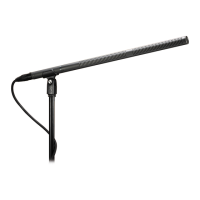
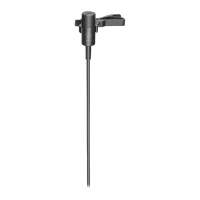

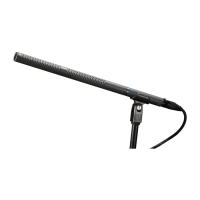
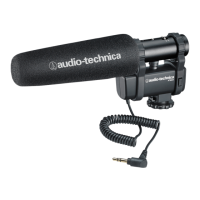
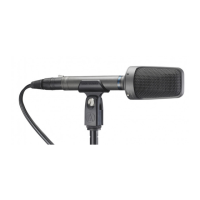





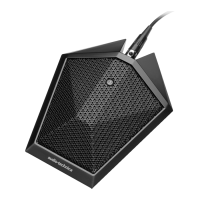

